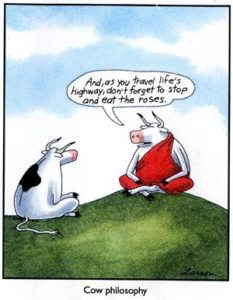 Musings
Musings  No Comments
No Comments Thinking is not Doing…
To accomplish anything ‘action’ is required.
 Musings
Musings  No Comments
No Comments To accomplish anything ‘action’ is required.
 Musings
Musings  No Comments
No Comments  By Brett and Kate McKay from their blog “The Art of Manliness”
By Brett and Kate McKay from their blog “The Art of Manliness”
Jun 05, 2017
The hallowing of Pain
Like hallowing of Heaven
Obtains at corporeal cost —
All — is the Price of All —
–Emily Dickinson
In the excellent and under-appreciated film Gattaca, biotechnology and advanced eugenics have divided the “not-so-distant” future into two groups: the “valid” and the “in-valid.”
The valids are those whose embryonic genes were pruned and manipulated to allow for their birth as genetically superior children, destined to bring to fruition their parents’ best hereditary traits.
The in-valids are those who were conceived naturally, by parents who played a game of genetic roulette. More likely to carry “flawed” DNA and more susceptible to genetic disorders and weaknesses, in-valids are barred from society’s important professions and consigned to menial work.
Vincent Freeman is an in-valid. With genes that indicate a high probability of several disorders and an estimated life span of 30.2 years, he works as a janitor while secretly dreaming of becoming an astronaut, a vocation from which he is disqualified.
Vincent’s brother, Anton, is a valid, and their sibling rivalry is heightened by their genetic divide.
Growing up, Vincent and Anton challenge each other to games of “chicken,” in which they both swim out into the ocean as far as they dare; the first one to turn back is the loser.
Vincent always loses, until one day he shocks Anton by outdistancing him. Anton, who cannot keep up, almost drowns, and has to be saved by his genetically inferior brother.
Years later, after an insatiably ambitious Vincent uses subterfuge to join the space program and earn a place, through merit, on a mission to Saturn, the brothers have a rematch. Once more the underdog bests his fraternal rival, who again must be rescued from drowning.
Astonished at this turning of the tables, Anton asks, “How are you doing this Vincent? How have you done any of this?”
To which his brother replies:
“You wanna know how I did it? This is how I did it Anton.
I never saved anything for the swim back.”
 Musings
Musings  No Comments
No Comments  Recently I ministered to a dear friend who had allowed depression and despair to embrace him for a while. He had been drowning in fears of financial insufficiency and mounting body challenges.
Recently I ministered to a dear friend who had allowed depression and despair to embrace him for a while. He had been drowning in fears of financial insufficiency and mounting body challenges.
He longed to feel useful to himself – and mostly to others.
Suspending judgments, we spoke of learned (and earned) personal experiences of N’Gup (Never Give Up!) and “it’s not over until I win”. We agreed that it was times like these to ‘own-up to our talk’.
I shared the recognized wisdom and inspiration that I have always received by reading and re-reading Viktor Frankl’s “Man’s Search for Meaning”. Frankl was a Jewish Psychiatrist from Austria that endured four years in German Concentration Camps during World War II.
Re-reading his book always reinforced me to embrace chosen Life Philosophies.
I advised that I would send my friend a list of some of my favorite powerful learnings from Frankl’s wisdom and we would discuss thereafter. Here are the passages that I shared:
Frankl also learned that developing a ‘sense of humor’ is a trick learned while mastering the art of living and, “Humor, more than anything else, is the Soul’s weapon to afford an aloofness and ability to rise above any situation.”
Together my friend and I contrived to answer our big question and opportunity, “What should we do to reframe our past experiences and current circumstances to use them as ‘Warm-up’ for our future growth and contributions?”
We agreed that the following mantras would be embraced and provide direction for all our attitudes and actions:

 Musings
Musings  No Comments
No Comments Recently I rediscovered this article by Mac Anderson in my list of inspirational stories. It is from 2009 – and very worth sharing.
The date was July 16, 2008. It was late in the afternoon and I was sitting in my hotel room in Louisville, Kentucky. I was scheduled to speak that evening for the Kentucky Association of School Administrators (KASA). I was a little “down in the dumps.” I hadn’t gotten to exercise lately because of my traveling schedule and recently I’d experienced some mild bouts of vertigo (that inner ear condition that can cause the room to start spinning.) You got it…speaking and “spinning” are not good partners!
My keynote presentation was scheduled for 7:00 PM, but I had been invited to show up at 6:00 to see a performance they said I’d enjoy. Little did I know that I was about to see something I would never forget.
They introduced the young musician. Welcome…Mr. Patrick Henry Hughes. He was rolled onto the stage in his wheelchair, and began to play the piano. His fingers danced across the keys as he made beautiful music.
He then began to sing as he played, and it was even more beautiful. For some reason, however, I knew that I was seeing something special. There was this aura about him that I really can’t explain and the smile…his smile was magic!
About ten minutes into Patrick’s performance, someone came on the stage and said…”I’d like to share a 7-minute video titled, The Patrick Henry Hughes story.” And the lights went dim.
Patrick Henry Hughes was born with no eyes, and a tightening of the joints which left him crippled for life. However, as a child, he was fitted with artificial eyes and placed in a wheelchair. Before his first birthday, he discovered the piano. His mom said, “I could hit any note on the piano, and within one or two tries, he’d get it.” By his second birthday, he was playing requests (You Are My Sunshine, Twinkle Twinkle Little Star). His father was ecstatic. “We might not play baseball, but we can play music together.”
Today, Patrick is a junior at the University of Louisville. His father attends classes with him and he’s made nearly all A’s, with the exception of 3 B’s He’s also a part of the 214 member marching band. You read it right…the marching band! He’s a blind, wheelchair-bound trumpet player; and he and his father do it together. They attend all the band practices and the half-time performance in front of thousands. His father rolls and rotates his son around the field to the cheers of Patrick’s fans. In order to attend Patrick’s classes and every band practice, his father works the graveyard shift at UPS. Patrick said…”My dad’s my hero.”
But even more than his unbelievable musical talent, it was Patrick’s “attitude of gratitude” that touched my soul. On stage, between songs, he would talk to the audience about his life and about how blessed he was. He said, “God made me blind and unable to walk. BIG DEAL! He gave me the ability…the musical gifts I have…the great opportunity to meet new people.”
When his performance was over, Patrick and his father were on the stage together. The crowd rose to their feet and cheered for over five minutes. It gave me giant goose bumps!
My life was ready to meet Patrick Henry Hughes. I needed a hero, and I found one for the ages. If I live to be a hundred, I’ll never forget that night, that smile, that music, but most importantly, that wonderful “attitude of gratitude.”
I returned to Chicago and shared Patrick’s story with my wife, my friends, and our team at Simple Truths. About two weeks later, I received a letter from a friend. He said, “Mac, I don’t know who said it, but I think you’ll love this quote.”
“Life is not about waiting for the storms to pass…
it’s about learning to dance in the rain!”
I thought…that’s it! We all face adversity in our life. However, it’s not the adversity, but how we react to it that will determine the joy and happiness in our life. During tough times, do we spend too much time feeling sorry for ourselves, or, can we, with gratitude…learn how to dance in the rain?
It almost sounds too simple to feel important, but one word…gratitude, can change your attitude, thus, your life, forever. Sarah Breathnack said it best…
“When we choose not to focus on what is missing from our lives but are grateful for the abundance that’s present….we experience heaven on earth.”

“What I just shared is the introduction to our new book, Learning to Dance in the Rain…The Power of Gratitude. My co-author is BJ Gallagher and she is one of the most talented and creative writers I’ve every known. It was an honor to work with her on this beautiful book that can truly change the way you think about life.” – Mac Anderson
 Musings
Musings  No Comments
No Comments Several times my daughter had telephoned to say, “Mother, you must come and see the daffodils before they are over.” I wanted to go, but it was a two-hour drive from Laguna to Lake Arrowhead. Going and coming took most of a day – and I honestly did not have a free day until the following week.
“I will come next Tuesday,” I promised, a little reluctantly, on her third call. Next Tuesday dawned cold and rainy. Still, I had promised, and so I drove the length of Route 91, continued on I-215, and finally turned onto Route 18 and began to drive up the mountain highway. The tops of the mountains were sheathed in clouds, and I had gone only a few miles when the road was completely covered with a wet, gray blanket of fog. I slowed to a crawl, my heart pounding. The road becomes narrow and winding toward the top of the mountain.
As I executed the hazardous turns at a snail’s pace, I was praying to reach the turnoff at Blue Jay that would signify I had arrived. When I finally walked into Carolyn’s house and hugged and greeted my grandchildren I said, “Forget the daffodils, Carolyn! The road is invisible in the clouds and fog, and there is nothing in the world except you and these darling children that I want to see bad enough to drive another inch!”
My daughter smiled calmly, “We drive in this all the time, Mother.”
“Well, you won’t get me back on the road until it clears – and then I’m heading for home!” I assured her.
“I was hoping you’d take me over to the garage to pick up my car. The mechanic just called, and they’ve finished repairing the engine,” she answered.
“How far will we have to drive?” I asked cautiously.
“Just a few blocks,”Carolyn said cheerfully.
So we buckled up the children and went out to my car. “I’ll drive,” Carolyn offered. “I’m used to this.” We got into the car, and she began driving.
In a few minutes I was aware that we were back on the Rim-of-the-World Road heading over the top of the mountain. “Where are we going?” I exclaimed, distressed to be back on the mountain road in the fog. “This isn’t the way to the garage!”
“We’re going to my garage the long way,” Carolyn smiled, “by way of the daffodils.”
“Carolyn, I said sternly, trying to sound as if I was still the mother and in charge of the situation, “please turn around. There is nothing in the world that I want to see enough to drive on this road in this weather.”
“It’s all right, Mother,” She replied with a knowing grin. “I know what I’m doing. I promise, you will ne ver forgive yourself if you miss this experience.”
ver forgive yourself if you miss this experience.”
And so my sweet, darling daughter who had never given me a minute of difficulty in her whole life was suddenly in charge – and she was kidnapping me! I couldn’t believe it. Like it or not, I was on the way to see some ridiculous daffodils – driving through the thick, gray silence of the mist-wrapped mountaintop at what I thought was risk to life and limb.
I muttered all the way. After about twenty minutes we turned onto a small gravel road that branched down into an oak-filled hollow on the side of the mountain. The fog had lifted a little, but the sky was lowering, gray and heavy with clouds.
We parked in a small parking lot adjoining a little stone church. From our vantage point at the top of the mountain we could see beyond us, in the mist, the crests of the San Bernardino range like the dark, humped backs of a herd of elephants. Far below us the fog-shrouded valleys, hills, and flatlands stretched away to the desert.
On the far side of the church I saw a pine-needle-covered path, with towering evergreens and manzanita bushes and an inconspicuous, lettered sign “Daffodil Garden.”
We each took a child’s hand, and I followed Carolyn down the path as it wound through the trees. The mountain sloped away from the side of the path in irregular dips, folds, and valleys, like a deeply creased skirt.
Live oaks, mountain laurel, shrubs, and bushes clustered in the folds, and in the gray, drizzling air, the green foliage looked dark and monochromatic. I shivered. Then we turned a corner of the path, and I looked up and gasped. Before me lay the most glorious sight, unexpectedly and completely splendid. It looked as though someone had taken a great vat of gold and poured it down over the mountain peak and slopes where it had run into every crevice and over every rise. Even in the mist-filled air, the mountainside was radiant, clothed in massive drifts and waterfalls of daffodils. The flowers were planted in majestic, swirling patterns, great ribbons and swaths of deep orange, white, lemon yellow, salmon pink, saffron, and butter yellow.
Each different-colored variety (I learned later that there were more than thirty-five varieties of daffodils in the vast display) was planted as a group so that it swirled and flowed like its own river with its own unique hue.
In the center of this incredible and dazzling display of gold, a great cascade of purple grape hyacinth flowed down like a waterfall of blossoms framed in its own rock-lined basin, weaving through the brilliant daffodils. A charming path wound throughout the garden. There were several resting stations, paved with stone and furnished with Victorian wooden benches and great tubs of coral and carmine tulips. As though this were not magnificent enough, Mother Nature had to add her own grace note – above the daffodils, a bevy of western bluebirds flitted and darted, flashing their brilliance. These charming little birds are the color of sapphires with breasts of magenta red. As they dance in the air, their colors are truly like jewels above the blowing, glowing daffodils. The effect was spectacular.
It did not matter that the sun was not shining. The brilliance of the daffodils was like the glow of the brightest sunlit day. Words, wonderful as they are, simply cannot describe the incredible beauty of that flower-bedecked mountain top.
Five acres of flowers! (This too I discovered later when some of my questions were answered.) “But who has done this?” I asked Carolyn. I was overflowing with gratitude that she brought me – even against my will. This was a once-in-a-lifetime experience.
“Who?” I asked again, almost speechless with wonder, “And how, and why, and when?”
“It’s just one woman,” Carolyn answered. “She lives on the property. That’s her home.” Carolyn pointed to a well-kept A-frame house that looked small and modest in the midst of all that glory.
We walked up to the house, my mind buzzing with questions. On the patio we saw a poster . “Answers to the Questions I Know You Are Asking” was the headline. The first answer was a simple one. “50,000 bulbs,” it read. The second answer was, “One at a time, by one woman, two hands, two feet, and very little brain.” The third answer was, “Began in 1958.”
. “Answers to the Questions I Know You Are Asking” was the headline. The first answer was a simple one. “50,000 bulbs,” it read. The second answer was, “One at a time, by one woman, two hands, two feet, and very little brain.” The third answer was, “Began in 1958.”
There it was. The Daffodil Principle.
For me that moment was a life-changing experience. I thought of this woman whom I had never met, who, more than thirty-five years before, had begun – one bulb at a time – to bring her vision of beauty and joy to an obscure mountain top. One bulb at a time.
There was no other way to do it. One bulb at a time. No shortcuts – simply loving the slow process of planting. Loving the work as it unfolded.
Loving an achievement that grew so slowly and that bloomed for only three weeks of each year. Still, just planting one bulb at a time, year after year, had changed the world.
This unknown woman had forever changed the world in which she lived. She had created something of ineffable magnificence, beauty, and inspiration.
The principle her daffodil garden taught is one of the greatest principle of celebration: learning to move toward our goals and desires one step at a time – often just one baby-step at a time – learning to love the doing, learning to use the accumulation of time.
When we multiply tiny pieces of time with small increments of daily effort, we too will find we can accomplish magnificent things. We can change the world.
“Carolyn,” I said that morning on the top of the mountain as we left the haven of daffodils, our minds and hearts still bathed and bemused by the splendors we had seen, “it’s as though that remarkable woman has needle-pointed the earth! Decorated it. Just think of it, she planted every single bulb for more than thirty years. One bulb at a time! And that’s the only way this garden could be created. Every individual bulb had to be planted. There was no way of short-circuiting that process. Five acres of blooms. That magnificent cascade of hyacinth! All, just one bulb at a time.”
The thought of it filled my mind. I was suddenly overwhelmed with the implications of what I had seen. “It makes me sad in a way,” I admitted to Carolyn. “What might I have accomplished if I had thought of a wonderful goal thirty-five years ago and had worked away at it ‘one bulb at a time’ through all those years. Just think what I might have been able to achieve!”
My wise daughter put the car into gear and summed up the message of the day in her direct way. “Start tomorrow,” she said with the same knowing smile she had worn for most of the morning. Oh, profound wisdom!
It is pointless to think of the lost hours of yesterdays. The way to make learning a lesson a celebration instead of a cause for regret is to only ask, “How can I put this to use tomorrow?”